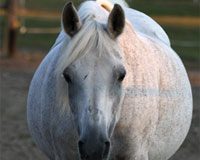
Q: I have a 17-year-old Arabian that I take to a local equine campground twice a year for several days. The past two times toward the end of our trip, he started having muscle spasms after I rode him, and got uncomfortable with shallow breathing. He’s on hay only, and I make sure he’s cooled out well before tying him back to his line. I think he might be tying up, but how do I know if this is what’s really happening? How can I stop it from happening again?
Several things come to mind as to the initial source of a muscle problem.
- Insufficient conditioning: If your horse hasn’t been conditioned for the intensity of what you are asking him to do on the trail for several consecutive days, his muscles may tire and he may experience some signs consistent with exhausted horse syndrome (EHS), such as myositis. EHS occurs due to fatigue, dehydration, and/or electrolyte imbalances. So, the way to avoid this is to prepare him in advance with a consistent, progressive conditioning program in the months prior to your multi-day outings.
- Electrolyte depletion or imbalance: If you are riding more than 15 or 20 miles each day and particularly in hot and humid weather conditions, it is a good idea to supplement your horse with balanced electrolytes. Two ounces of a salt mixture (two parts sodium chloride to one part potassium chloride) given via syringe in the middle of your ride and again at the end should suffice for each dose. A commercial paste product is suitable so long as it’s 100 percent salt and not sugar-based, as many tend to be.
Dietary issues, such as feeding too much grain before or during your camping stay, can alter muscle metabolism and lead to tying up after exertional riding. It sounds like you already limit grain and maximize forage intake, but adding fat to the diet could also be helpful for efficient muscle metabolism. Ask your vet to help you fine-tune an appropriate diet.
Some lines of Arabians—as well as some Quarter Horses, Paints, Appaloosas, warmbloods and drafts—have a genetic predisposition to developing polysaccharide storage myopathy (PSSM). You should discuss with your vet about performing muscle testing to check for this glycogen storage disorder. Dietary strategies, such as feeding high levels of fat and removing all sugar-based feeds (grains) from the diet helps limit episodes of related muscle cramping and stiffness.
The best way to resolve your horse’s issue is to try to get to the heart of what is causing it so you know how to address his specific needs. A thorough physical exam, bloodwork and possibly muscle biopsy testing may shed some light on his metabolic condition.
NANCY S. LOVING, DVM, is a performance horse veterinarian based in Boulder, Colo., and is the author of All Horse Systems Go.
This article originally appeared in the November 2014 issue of Horse Illustrated magazine. Click here to subscribe!






Learn some new things, once again. Thank You for providing interesting health topics.
great info
Information is right on with my vet. My gelding started this several years back. He was given selenium in his feed. He would sweat profusely from the pain and touching him where his kidneys would hurt him badly. He came out of it with similar instruction as was mentioned.